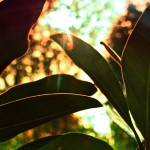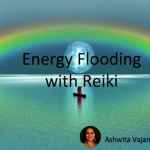Article by Isabella Dove, Reiki Master
According to you is Reiki a word or a verb? Do you “Reiki” something or someone or do you “give” someone Reiki? Do you actually “give” Reiki or “apply” Reiki to something or someone? Depending on your vernacular language your statement may be different but in your own language, how do you express the idea that you practice, use, send, think of Reiki? Written as we do, the word pronounced as ‘Rei- Ki” is widely understood as a practice, a natural healing treatment and a way to consciously connect to a source of energy with a purpose of healing. What about using the word Reiki as a verb? What is your take on this point? From the perspective of the energy field which the practitioner is tapping into is there really a separation? Could we, as energy beings having a physical life on Earth, shift our view on the energetic paradigm and start moving away from an experience of “doing” something and start living an experience of “being”? This would mean changing our reading lens of the reality and start experiencing the practice of Reiki as a flow of energy compared to a topical application of techniques at some point in time – past, present, future – to facilitate a desired result. Maybe the comparison is simplistic however the questions maybe expressing the idea that from a world of separation we could indeed opt for a world of cooperation within a new energetic paradigm.
Per se and written as we do here, the word Reiki is a westernized transliteration of a Japanese expression describing the surrounding universal energy we all are connected with – again as energy beings. Going back to basics to where the practice of Reiki originates gives abundant information to understand a bit more about the metaphoric expressions within languages in some parts of Asia. Oriental languages are in essence very descriptive and often the contraction of two or more ideograms (or kanji in Japanese) which may often have several meanings, if not even having completely different meaning depending on the pronunciation. Moreover, there also is a strong acceptance within Asian cultures that words have power and express an intention. Words and thoughts are energy and the law of attraction is a corollary of the law of karma as in “What goes around comes around”. Within most countries in Asia and within the commonly-known as Far East region even more so, it is quite widely implicitly practiced simply because it has quite a strong corollary in the metaphoric language itself. To build a word or an expression it is necessary to gather few pieces of ‘kanji’ or “ideograms” and put them together and this is a quite different cognitive process from a creating sequence of linear words to make a meaningful sentence! The wheel of life seems to be rolling in and out continuously from thoughts, actions and words. In other words the law of karma is energy itself!

Image by q8
Within the Reiki system of natural healing there are several words, expressions and ‘kotodama’ used to express techniques and protocols for healing. The word kotodama comes from ancient Japan tradition of the imperial officers and is also totally embedded in the practice of martial arts. The word kotodama expresses itself the idea that there is a soul in a sound and that the sound carries energy into the universe. Another example of this word-thought-energy is the use of “mantra” in several parts of Asia, as in “Om Mani Padme Hum” which is also connected to the practice of Tantric Buddhism, Himalayan Buddhism, Theravada Buddhism in South East Asia, Ancient Buddhist school of Zen (“Chan” in Chinese) and Hinduism which also has its list of mantras used to honor one or several gods and goddesses and to express either offerings, prayers or simply to invoke inherent sacred powers.
Besides oriental languages, many other parts of the world have metaphoric languages and sacred sounds are being practiced as connectors to a source of energy beyond our own little mind. Think of the Sufis in particular with body movements and music creating quite a vortex of spiritual energies around their aura. Within most Asian cultures, the practice of meditation is widely accepted and not only as an expression of the cultural Buddhist background, rather also as a way to connect to energies. People quite easily connect to the principle of words, thoughts and actions and tend to understand quite implicitly the metaphoric connection between a word and its energy. As an observation, teaching Reiki in an Asian context as I have done in the past years, including having taught Reiki I and II to a Japanese student confirmed this quite substantively. So what is it that connects this metaphoric energetic package of words, thoughts and actions to the practice of energy healing? What is there within the aura of a Sufi dancer that creates a healing energy through him and upon him? What is there within the power of a mantra that creates the bond between the speaker and the energy itself? What gives the martial artist a phenomenal power of concentration allowing the most magnificent connections with the surrounding energies?
Think of a moment of a meditator experiencing the silence of the mind – easily or not. Is s/he trying to meditate? Or is s/he meditating? The use of conscious language and action word significantly and surprisingly could completely shift the experience of meditation. In the middle of the Zazen meditation session the Zen master loudly voiced out “Be Zen” don’t just “do Zen” and the student had a flash of light! Yes, this is how it works. Before sitting in meditation just accept within your consciousness to live in the now and be meditation. Sure, keep the ego away, and don’t just polish your own experience, remain humble.
Now, what about just “Be Reiki” rather than “Do Reiki”. What difference would it make? Where would the focus be that would make it a leap forward both in terms of practice and for the connection to the quantum field around us? Most likely it would just be a matter of consciousness, a matter of intention and focused energy put into it. In “being” Reiki, the tapping into the energy field is spontaneous and instantaneously put into use. In “doing” Reiki there is a sort of switch on-off separation button. This reminds us of a story of Mrs. Hawayo Takata instructing her students while teaching Reiki in Hilo (Big Island, Hawai’i) that starting from the moment one is attuned to Reiki there is no more life without Reiki. The person becomes a “Reiki mobile device”, a “consistent, abundant, regular, flow of Reiki energy” there is no more out-of-Reiki state. Only the consciousness of ‘being’ Reiki makes the difference. As in life itself, it all is in the consciousness. Just Be Reiki and let the flow abundantly shower the reality and the bond so created between you and the source. Let the flow guide you and relax. Just be! In the end it is all a matter of consciousness, energy and focused intention, like in the martial arts, the connection can be rather surprisingly powerful.

Isabella Dove
Isabella Dove founded Healing Mudras a small studio acting as a hub for holistic artists and healing arts in Vientiane, Lao PDR. She practices Reiki since 1999, lived in 15 countries over 4 continents and brought Reiki as an ally to experiences several realities. After becoming a Usui Reiki Master Teacher in 2008 she travelled to Hawai’i and studied directly with William Rand, Founder & Director of the International Center for Reiki Training (US) and trained as Karuna® Reiki Master Teacher in 2010. This was a breakthrough and a further leap in the practice as Karuna® Reiki brings a firmer alignment and synchronicity with grounding bodhisattva energies. Isabella is a Certified Personal Integral Coach and teaches Reiki, Yin Yoga and DancEnergetics. Visit Healing Mudras at http://thehealingmudras.blogspot.com or http://www.linkedin.com/in/healingmudras





Reiki Isabella,
One of the best information I read about Reiki from start of my Reiki journey. It really shifts the way I look things while giving Reiki and Reiking things. It really gave me shift in my awareness.
With peace, love and light
chetan